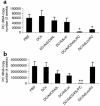CD4+ T cell-independent vaccination against Pneumocystis carinii in mice
- PMID: 11714738
- PMCID: PMC209424
- DOI: 10.1172/JCI13826
CD4+ T cell-independent vaccination against Pneumocystis carinii in mice
Abstract
Host defenses are profoundly compromised in HIV-infected hosts due to progressive depletion of CD4+ T lymphocytes. Moreover, deficient CD4+ T lymphocytes impair vaccination approaches to prevent opportunistic infection. Therefore, we investigated a CD4+ T cell-independent vaccine approach to a prototypic AIDS-defining infection, Pneumocystis carinii (PC) pneumonia. Here, we demonstrate that bone marrow-derived dendritic cells (DCs) expressing the murine CD40 ligand, when pulsed ex vivo by PC antigen, elicited significant titers of anti-PC IgG in CD4-deficient mice. Vaccinated animals demonstrated significant protection from PC infection, and this protection was the result of an effective humoral response, since adoptive transfer of CD4-depleted splenocytes or serum conferred this protection to CD4-deficient mice. Western blot analysis of PC antigen revealed that DC-vaccinated, CD4-deficient mice predominantly reacted to a 55-kDa PC antigen. These studies show promise for advances in CD4-independent vaccination against HIV-related pathogens.
Figures




References
-
- Fauci AS, et al. NIH conference. Acquired immunodeficiency syndrome: epidemiologic, clinical, immunologic, and therapeutic considerations. Ann Intern Med. 1984;100:92–106. - PubMed
-
- Phair J, et al. The risk of Pneumocystis carinii pneumonia among men infected with human immunodeficiency virus type I. N Engl J Med. 1990;322:155–161. - PubMed
-
- Autran B, et al. Positive effects of combined antiretroviral therapy on CD4+ T cell homeostasis and function in advanced HIV disease. Science. 1997;277:112–116. - PubMed
-
- Connors M, et al. HIV infection induces changes in CD4+ T-cell phenotype and depletions within the CD4+ T-cell repertoire that are not immediately restored by antiviral or immune-based therapies. Nat Med. 1997;3:533–540. - PubMed
-
- Marcotte H, et al. Pneumocystis carinii infection in transgenic B cell-deficient mice. J Infect Dis. 1996;173:1034–1037. - PubMed
Publication types
MeSH terms
Substances
Grants and funding
LinkOut - more resources
Full Text Sources
Other Literature Sources
Research Materials

